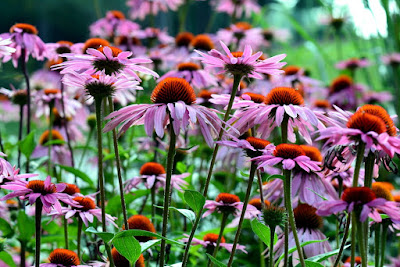It's Wildflower Wednesday and today I wanted to talk about one of my favorite summer bloomers, Echinacea. Echinacea, commonly called coneflowers, are long lasting, blooming from spring through fall. They provide a lot of insect activity making it a must have plant for any garden with sunshine. We have experimented growing three different species in our garden: Echinacea purpurea, tennesseensis, and sanguinea.
Echinacea purpurea also known as purple coneflower is a wide spread perennial that is native to most of eastern North America. It isn't picky about growing conditions. Give it sun and it will tolerate drought, poor soil conditions, heat and humidity.
 |
| E. purpurea |
Pollinators love coneflowers. The large landing pad invites a variety of butterflies, beetles, and long-tongued bees to enjoy the nectar.
 |
| E. tennessensis |
Echinacea tennessensis is a more rare coneflower native to Tennessee. Once a Federally listed endangered plant species it was delisted in 2011 thanks to conservation efforts. This species has a less vigorous growth habitat than other species. Unlike E. purpurea, the petals of this coneflower are more erect and deeper pink in color. Note, that if you want to retain the genetic integrity of this coneflower to harvest seeds, it will need to be grown in isolation from other Echinacea species.
 |
| E. tennesseensis |
Echinacea sanguinea is the most southernly ranging of all the coneflowers. It is native to prairies of eastern Texas and found in southeastern Oklahoma and Louisiana and southwestern Arkansas. This graceful coneflower grows about 3 inches above its base of leaves and is an important nectar source for our native bees.
 |
| E. sanguinea |
Sanguinea is not as cold hardy as other echinacea but it has done well in our garden. The rays are more narrow than purpurea and tennessensis and the center disk is a much deeper red color.
 |
| E. sanguinea |
What I really like about echinacea is the structure of the flower. The prominent cone shaped head of the inflorescence looks gorgeous in summer, fall and winter.
 |
| American Goldfinches foraging on seeds in winter |
Echinaceas are an invaluable plant in the summer and fall/winter garden. They look great paired with grasses, rudbeckia, liatris, and many other meadow/prairie plants. If you don't already have them growing in your garden add some!
Note on hybrids: There are many hybrid coneflowers on the market. Most are breed from E. purpurea. There are inconclusive studies whether or not the hybrids are beneficial to pollinators. What is known is that double blooms are useless to insects because the extra petals block nectar and pollen. Some hybrids are sterile and therefore don't produce seed that support birds and other wildlife so be mindful of your choices when shopping for this plant. Over the years we have fallen for some of the beautiful hybrids and have found that they do support pollinators often.
 |
| Echinacea hybrid: PowWow Wildberry with yarrow |
 |
| Echinacea hybrid: Cheyenne Spirt with rattlesnake master seedlings |
Thanks to Gail at
Clay and Limestone for hosting Wildflower Wednesday and all the folks sharing the great native wildflowers growing in their gardens.









.png)
